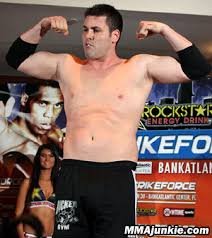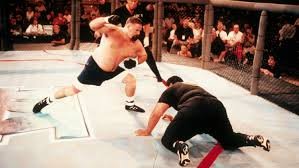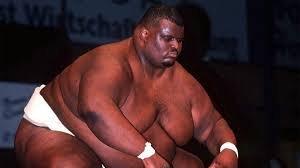A world where athleticism, skill, and strategy converge to form its core is the world of mixed martial arts (MMA). In this world, the UFC has witnessed a diverse range of fighters, each with unique physical attributes and fighting styles. While agility and speed often play an undisputed role, the heavyweight division has seen its fair share of colossal figures who have captivated audiences with their sheer size and strength. They have also produced some of the most memorable moments in the UFC.
The UFC heavyweight division has always been a breeding ground for colossal athletes, attracting fighters with imposing physiques and awe-inspiring power. These giants of the sport often possess unique strengths and weaknesses, and their presence in the octagon has always been a spectacle for fans.
In the early days of the UFC, the weight limit for the heavyweight division was virtually non-existent, leading to a diverse array of fighters with varying body types and backgrounds. This created a unique landscape where behemoths could clash with smaller, more agile opponents, leading to some of the most memorable and unpredictable fights in UFC history. We will take a look at the different sizes of these fighters, and how they made a name for themselves.
GIANTS OF THE OCTAGON:
10. Gan McGee (~260lbs):

Gan McGee was one of the early pioneers of the UFC’s heavyweight division. Standing at 6’10” and weighing around 265 lbs, McGee was known for his intimidating size and powerful punches.
McGee’s UFC career included notable fights against Pedro Rizzo and Josh Barnett. He had a reputation for being a tough opponent, often pushing his adversaries to their limits. While he never captured a UFC championship, McGee’s contributions to the early development of the heavyweight division are noteworthy.
McGee recorded 18 wins and 8 losses. His career spanned various organizations, showcasing his longevity and resilience as a heavyweight competitor. Although he may not be as widely recognized as some of the other names on this list, McGee’s place in UFC history as an early contender deserves recognition.
9. Brock Lesnar (~280 lbs):

The former WWE superstar shocked the MMA world when he transitioned to the UFC and quickly captured the heavyweight title. His size, strength, and wrestling background made him a nightmare matchup for many opponents. Brock Lesnar is a unique figure who achieved success in both professional wrestling (WWE) and MMA. Known for his immense strength, athleticism, and aggressive fighting style, Lesnar quickly rose through the ranks of the UFC’s heavyweight division.
Lesnar captured the UFC Heavyweight Championship in just his fourth professional MMA fight, defeating Randy Couture. He successfully defended the title twice before a bout with diverticulitis hampered his career. Despite his relatively short stint in the UFC, Lesnar’s impact was undeniable, drawing massive pay-per-view audiences and generating immense interest in the sport.
Lesnar’s overall MMA record is 5 wins (4 by KO/TKO) and 3 losses, with 1 no contest. While his UFC career was cut short, his achievements as a champion and his ability to transcend the boundaries of combat sports solidified his status as a crossover superstar.
8. Semmy Schilt (~340lbs):

Semmy Schilt is a legend in the world of kickboxing, holding numerous titles in the prestigious K-1 organization. Standing at 6’11” and weighing around 340lbs, Schilt’s imposing stature and devastating kicks made him a fearsome competitor.
Schilt’s transition into MMA was not brief, making an impact beyond words can say. In the UFC, he participated in his first fight, defeating Pete Williams via TKO. His second and last fight came at UFC 32 losing against Josh Barnett.
Schilt’s overall MMA record is 26 wins (14 by KO/TKO) and 14 losses. However, his legacy is primarily defined by his remarkable kickboxing career, where he achieved numerous championships and solidified his place as one of the greatest heavyweight strikers in combat sports history.
7. Tim Sylvia (~260 lbs):

A two-time UFC Heavyweight Champion, Sylvia was a dominant force in the division during his prime. His height and reach allowed him to control the distance and punish opponents with his striking. Tim “The Maine-iac” Sylvia stands as a towering figure in UFC history, both literally and figuratively. At 6’8″ and typically weighing around 265lbs, Sylvia was a dominant force in the heavyweight division. He secured the UFC Heavyweight Championship not once, but twice, and holds the record for the most consecutive title defenses in the division’s history (three).
Sylvia’s career was marked by impressive victories over notable opponents like Andrei Arlovski and Ricco Rodriguez. His fighting style was characterized by his reach advantage, powerful strikes, and surprising agility for a man of his size. However, Sylvia also faced challenges, notably losses to Randy Couture and Antonio Rodrigo Nogueira, which ultimately led to him losing the championship.
Sylvia’s overall MMA record stands at 31 wins (22 by KO/TKO), 10 losses, and 1 no contest. While his UFC career eventually came to an end, his legacy as a two-time champion and a dominant force in the heavyweight division remains cemented in the annals of MMA history.
6. Wes Sims (~260 lbs):

Nicknamed “The Project,” Sims was a towering figure in the UFC, known for his raw power and intimidating presence. While his technical skills were limited, his size and aggression made him a fan favorite. Weighing in at over 300 pounds during his UFC career, he was a true giant in the heavyweight division.
He made his UFC debut in 2002 at UFC 38, showcasing his brute strength and unorthodox striking. Although his initial run in the UFC was marked by a series of losses, Sims quickly gained notoriety for his controversial fights and larger-than-life personality.
One of Sims’ most infamous moments came during his bout against Frank Mir at UFC 43. The fight ended in controversy as Sims was disqualified for stomping on Mir’s head while he was down. This incident, along with other questionable tactics, cemented Sims’ reputation as a wild and unpredictable fighter. Sims also engaged in a heated rivalry with fellow heavyweight Tim Sylvia, culminating in a controversial match at SuperBrawl 38. While the fight ended in a no-contest due to an illegal knee strike by Sims, it further solidified his status as a polarizing figure in the sport.
5. Thomas Ramirez (~400lbs):

Standing 6 feet 1 inch tall and weighing around 410 pounds, Ramirez was one of the heaviest fighters to ever step into the UFC octagon. His imposing figure and significant weight made him a notable competitor in the evolving world of mixed martial arts.
Ramirez made his sole UFC appearance at UFC 8, held on February 16, 1996, in Puerto Rico. The event was part of the UFC’s early years when tournaments featured fighters from various disciplines battling to prove the superiority of their martial art styles. Ramirez’s background was primarily in boxing, which he brought to the octagon against a diverse array of fighting styles.
In his UFC debut, Ramirez faced Don Frye, an accomplished wrestler and boxer. The bout between Ramirez and Frye was highly anticipated due to the stark contrast in their physiques and fighting backgrounds. Despite Ramirez’s size advantage, the fight was over almost as soon as it began. Frye quickly closed the distance and landed a series of rapid punches, knocking Ramirez out in just 8 seconds. This quick knockout set a record at the time and remains one of the fastest finishes in UFC history.
Following his brief and unsuccessful foray into the UFC, Thomas Ramirez did not continue with a career in mixed martial arts. His loss to Don Frye effectively marked the end of his involvement in the sport at a high level. Unlike some of his contemporaries, Ramirez did not transition to other fighting organizations or roles within the MMA community.
4. Koji Kitao (~390lbs):

Koji Kitao, a former sumo grand champion (yokozuna), was a unique figure in the early days of the UFC. Standing at 6’7″ (201 cm) and weighing in at approximately 390 lbs (177 kg) during his UFC debut at UFC 9, Kitao brought a distinct background and skillset to the sport.
While his MMA career was brief, consisting of only three fights, Kitao’s presence in the octagon was significant. His background in sumo, a sport steeped in tradition and ritual, offered a stark contrast to the raw, no-holds-barred nature of the early UFC. Kitao’s sumo experience gave him a clear advantage in terms of size, strength, and raw power. However, his lack of experience in striking and grappling proved to be a challenge in the fast-paced and unpredictable world of MMA.
Despite his limited success in the cage, Kitao’s participation in the UFC was a testament to the sport’s early openness to diverse fighting styles and backgrounds. His fights were a spectacle, drawing attention to the potential crossover between Sumo and MMA.
3. John Matua (~400lbs):

John Matua is best remembered for his brief yet notable stint in the early days of the Ultimate Fighting Championship. With a background in traditional Hawaiian martial arts, including Kuialua—a form of Hawaiian bone-breaking combat—Matua brought a unique fighting style to the UFC. Weighing around 400 pounds and standing 6 feet 2 inches tall, Matua’s size and martial arts expertise made him a formidable presence in the octagon.
Matua’s debut came at UFC 6, held on July 14, 1995. This event was part of the early UFC tournaments that featured fighters from various disciplines competing against each other to determine the most effective martial art in no-holds-barred combat. Matua faced David “Tank” Abbott, a street fighter and wrestler known for his brute strength and aggressive fighting style.
John Matua’s career in the UFC was short, and he did not achieve significant success in mixed martial arts following his loss to Tank Abbott. After his brief appearance in the UFC, Matua largely faded from the spotlight and did not become a recurring figure in the sport. His fight with Abbott, however, remains a pivotal moment in UFC history, often cited in discussions about the evolution of the sport and the intense nature of its early competitions.
2. Teila Tuli (~450 lbs):

Or otherwise known as “Taylor Wily,” Tuli was a professional wrestler who transitioned to MMA from sumo wrestling. His massive frame and raw power made him a difficult opponent to handle, even for experienced fighters. His fight against Gerard Gordeau at UFC 1 is considered one of the most bizarre and memorable bouts in UFC history.
Tuli’s entry into the UFC came at UFC 1, held on November, 1993. This event was historic, as it marked the birth of what would become the world’s premier mixed martial arts organization. UFC 1 featured an open-weight tournament with fighters from various disciplines competing against each other to determine the most effective martial art. In his first and only UFC fight, Tuli faced Gerard Gordeau, a Dutch Savate and kickboxing expert. The bout was brief as it was memorable. Within the opening seconds, Gordeau landed a powerful kick to Tuli’s face, knocking out several of his teeth and forcing the referee to stop the fight. The match lasted only 26 seconds, and Tuli’s UFC career ended as quickly as it began. Despite the short duration, the fight is often remembered for its brutal and raw depiction of early MMA combat.
- Emmanuel Yarborough (600+ lbs):

This gentle giant holds the record for the heaviest fighter in UFC history. A former sumo wrestler and American football player, Yarborough brought a unique athletic background to the sport. Although his MMA career was brief, his sheer size and presence made him a spectacle to behold.
Born on September 5, 1964, in Rahway, New Jersey, Yarborough’s size and strength were apparent from a young age. Standing at an imposing 6 feet 8 inches and weighing over 600 pounds during his peak, Yarborough’s physical presence was unmatched in the world of mixed martial arts. Yarborough’s switch to sumo saw him earn the title of “World Amateur Sumo Champion,” and his success in this arena earned him a place in the Guinness World Records as the world’s heaviest living athlete. In 1994, Yarborough made his UFC debut at UFC 3, an event that showcased fighters of vastly different disciplines and sizes. Yarborough’s size was a spectacle in itself, and his presence brought significant attention to the event. He faced off against Keith Hackney, a much smaller yet agile fighter. The bout was a dramatic clash of styles and sizes, epitomizing the early days of the UFC when fighters from diverse backgrounds competed under a minimal rule set.
Despite his considerable weight advantage, Yarborough’s UFC debut did not end in victory. Hackney’s speed and striking ability allowed him to exploit Yarborough’s lack of mobility, leading to a first-round stoppage. This fight remains one of the most memorable mismatches in UFC history and highlighted both the advantages and limitations of Yarborough’s extraordinary size. Although his UFC career was brief, Yarborough’s impact on the sport was significant.
This list would not be complete without the honorable mention of Stefan Struve, who like other heavier fighters in the UFC, their presence has had significant impacts on the sport. Their unique skill sets and physical attributes have forced opponents to adapt their strategies, leading to the development of new techniques and tactics.
Smaller fighters have learned to utilize speed, agility, and leverage to overcome the size disadvantage. They have also developed techniques like leg kicks and takedowns to neutralize the power of larger opponents.
On the other hand, heavier fighters have learned to use their size and strength effectively. They have developed strategies to maintain top control on the ground and to avoid being taken down by smaller opponents.



